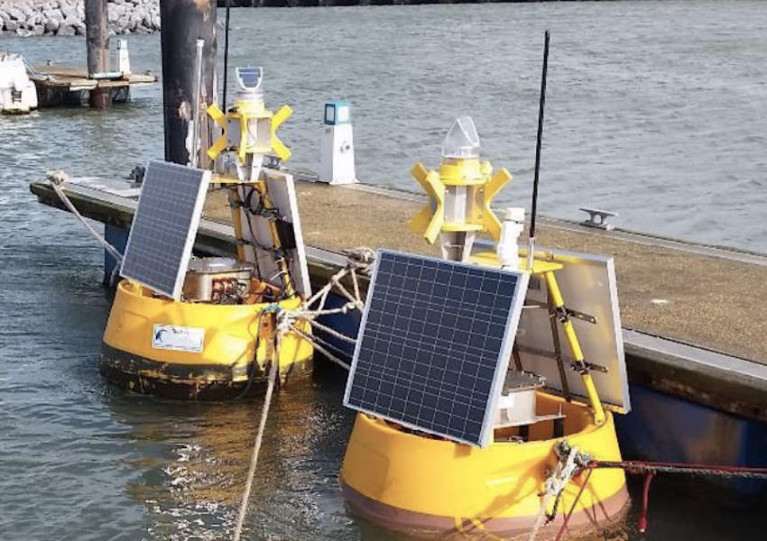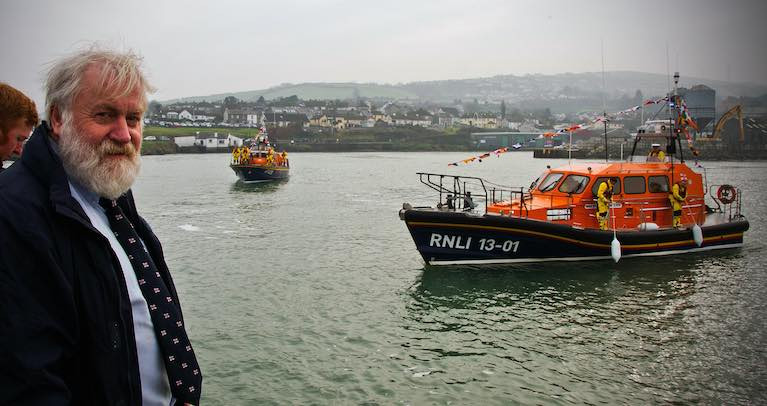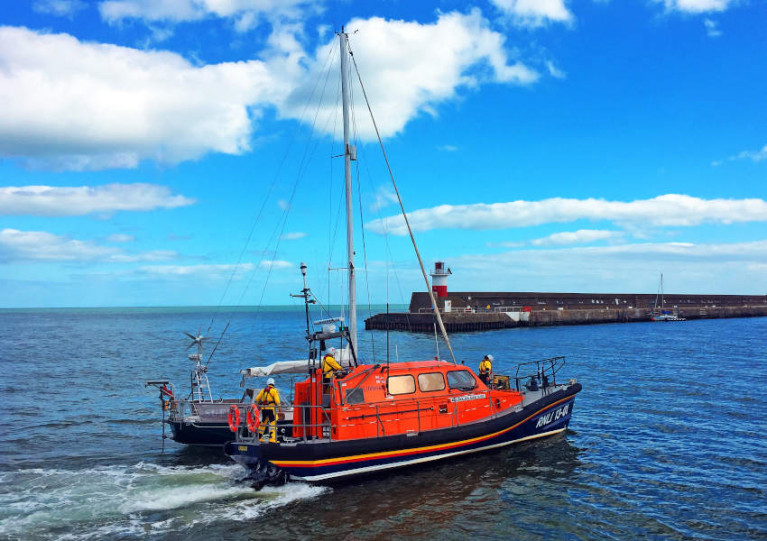Displaying items by tag: Wicklow
Wicklow RNLI Lifeboats in Rescue after Swimmers Go to the Aid of Young Girls on Inflatable
Both Wicklow RNLI lifeboats were launched shortly before 5:30 pm this evening following reports of two swimmers in difficulties on an inflatable toy off the Silver Strand beach south of Wicklow Head.
The Inshore lifeboat arrived on scene at 5:38 pm and located four people on rocks near the beach. Two men who were on the beach with their families were concerned about the two young swimmer’s safety and entered the water to help them. They managed to get them up onto rocks near the beach.
Conditions at the scene were wind north-easterly force four with a moderate sea. The inshore lifeboat crew took the four people from the rocks and transferred them to the all-weather lifeboat which was standing by offshore. ‘Rescue 116’ stood by overhead as the casualties were transferred to the lifeboat.
The winchman was lowered onto the lifeboat to carry out a medical assessment of the four casualties. The two young girls were then transferred to the Coast Guard helicopter and flown to Dublin Airport, where they were met by an Ambulance crew and brought for further medical attention.
The two men, who had rescued the two girls did not require any further medical assistance and were brought back to Wicklow harbour for a well-deserved hot drink at the lifeboat station after their quick intervention to help the young girls.
Speaking after the callout, Wicklow RNLI Press Officer, Tommy Dover said, ‘The quick actions of the two swimmers who went to the aid of the young girls resulted in a positive outcome this afternoon and we would urge people not to use inflatable toys on the beach.’
The main route onto one of Co Wicklow’s most popular beaches has sold at auction for more than three times the asking price.
And as The Irish Times reports, Wicklow County Council was outbid for the 21-acre site above Magheramore Beach which went for a whopping €700,000.
As previously noted on Afloat.ie, it’s feared that public access to the beach could be interrupted by the sale of the overlooking lands.
The sale has been “the most talked about story in Co Wicklow”, said Local auctioneer Catherine O’Reilly, who also failed to assuage fears with her belief that “the right of way is not registered”.
However, local TD John Brady said any attempt to restrict public access to the beach “will not be tolerated and will be bitterly opposed”.
The Irish Times has much more on the story HERE.
Shortly after 11 pm this Saturday evening, Wicklow RNLI volunteers were assembling at the lifeboat Station following a Coast Guard pager alert.
Ten minutes later at 11:13 pm Wicklow RNLI all-weather lifeboat slipped its moorings at the south quay and proceeded north to investigate reports of a yacht experiencing difficulties south of Greystones.
The yacht with three people on board was located four miles south of Greystones at 11:45 pm. Weather conditions at the scene were good with calm sea and light airs.
An assessment was carried out and the yacht was found to have a rope fouled in the propeller, efforts were made by the lifeboat crew to free the obstruction, but some rope remained tangled in the propeller shaft. This prevented the engine from being started and the yacht from making its own way to port.
Coxswain Keogh made the decision that undertaking a tow to Greystones harbour was necessary and the safest way to assist the sailors. The yacht was brought alongside Greystones Marina at 00:45 am on Sunday morning and the three sailors landed safely ashore.
The Lifeboat crew then proceeded back to Wicklow harbour arriving back on station at 1:30 am
Speaking after the callout, Wicklow RNLI Press officer, Tommy Dover said: ‘This was the first callout by the all-weather lifeboat crew using the new towing equipment.’
The crew on the callout were Coxswain Nick Keogh, Mechanic Tommy Murphy, Graham Fitzgerald, Paul Sillery, John Stapleton and Ian Thompson.
Public access to one of Co Wicklow’s most popular beaches could be interrupted by the sale of overlooking lands, as The Irish Times reports.
A 21-acre site that serves as the route onto Magheramore Beach, north of Brittas Bay on the Wicklow coast, has previously changed hands a number of times and is once again up for sale, with an online auction scheduled to begin in 25 June.
The Irish Times has more on the story HERE.
Two New Deputy Lifeboat Coxswains Appointed at Wicklow RNLI
Wicklow RNLI volunteers Graham Fitzgerald and Alan Goucher have been passed out as deputy coxswains by an RNLI Trainer Assessor, after undertaking months of training and completing a rigorous exercise on the all-weather lifeboat in Wicklow bay.
Graham Fitzgerald who has been a volunteer crew member for the past eleven years, and Alan Goucher who joined Wicklow RNLI in 2011, launched on an operational exercise with an RNLI Assessor during the week. The exercise involved boat handling tests and various emergency situations to test their skills. Both volunteers successfully carried out the tasks and were passed out as deputy coxswains by RNLI Trainer Assessor Alan Pryce after completing the exercise.
Over the last decade, Alan Goucher and Graham Fitzgerald have been involved in many rescues and in July 2014 they were praised for their bravery when they pulled a woman from the water and saved her life at the Silver Strand Beach. Graham and Alan received letters of commendation from the Operations Director of the RNLI George Rawlinson, for their actions during the rescue in 2014.
In the letter to Alan, Mr Rawlinson wrote: 'Your willingness to swim into the cave and use of your local knowledge to extricate the casualty safely ensured a good outcome on this rescue. I commend your commitment and professionalism.'Mr Rawlinson commended Graham Fitzgerald on his quick decision making, saying: 'During the rescue, you demonstrated calm and sound command of the incident, quickly gaining the required information and assessing the risks involved in committing your crew to enter the water.'
Wicklow RNLI Operations Manager, Mary Aldridge said: ‘Alan and Graham have over 22 years’ service between them as volunteers at RNLI Wicklow, and we are delighted with their achievement this week. Both have grained a lot of experience and have been involved in numerous rescues resulting in the saving of many lives. They have both worked extremely hard during the assessment to become deputy coxswains. This was made more difficult in recent times with Covid-19 and the suspension of training for a time. Great credit for Alan and Graham’s achievement is also due to the support from their families, trainers, assessors, and the crew who generously shared their knowledge and experience to prepare Alan and Graham as deputy coxswains.’
Wicklow RNLI Lifeboat Assist Three Fishermen
The Wicklow all-weather lifeboat RNLB Joanna and Henry Williams launched at 4:10 pm this afternoon following a launch request from the Coast Guard, to assist a 10-metre fishing vessel in difficulties ten miles offshore.
The lifeboat crew located the stricken vessel with three crew eight miles east of Wicklow Head thirty minutes after launching. The vessel was found to have a rope fouled in the propeller. Conditions on scene were moderate sea with wind north-easterly force 5 and good visibility.
Speaking after the callout, Coxswain Nick Keogh said: ‘We managed to cut the rope away from the propeller and the vessel was able to get underway again. The fishermen wanted to continue fishing and no further assistance was required.’
The lifeboat returned to Wicklow harbour and was alongside the South quay by 5:30pm.
The crew on the callout were Coxswain Nick Keogh, Mechanic Lisa O Leary, Tommy Murphy, Paul Sillery, John Stapleton and Ian Heffernan.
Wicklow RNLI Tow Fishing Vessel with Steering Problems to Safety
The all-weather relief fleet lifeboat RNLB Joanna and Henry Williams put to sea shortly after 1:30 pm this afternoon (Wednesday 24 March) under the command of Coxswain Nick Keogh and a volunteer crew, following a launch request from the Coast Guard.
The alarm was raised after the skipper of a 10-metre fishing vessel contacted the Coast Guard to say his vessel was caught up in ropes and unable to steer.
The lifeboat crew located the stricken vessel with two crew about four miles south-east of Wicklow harbour twenty minutes after launching. Conditions on scene were moderate sea with wind south-westerly force 5 and good visibility.
Speaking after the callout, Coxswain Nick Keogh said: ‘The crew made repeated attempts to cut the rope free from the jammed rudder, but it was decided the best option was to tow the fishing vessel back into Wicklow harbour.’
A towline was quickly established, and the fishing vessel with two crew was brought safely alongside the East pier at 2:45 pm.
The crew on the callout were Coxswain Nick Keogh, Mechanic Brendan Copeland, Lisa O’ Leary, Carol Flahive, Graham Fitzgerald and Peter Byrne.
Techworks Marine Schedules Wave Buoy Deployment Off Wicklow
TechWorks Marine has scheduled the deployment of a wave buoy off the coast of Wicklow on Tuesday 8 December, weather allowing.
The buoy will be a yellow DB 500 and have a flashing light sequence of five flashes every 20 seconds, with a range of three nautical miles. The buoy will be marked with a St Andrew’s sross and radar reflector.
The wave buoy will be deployed at 53° 2' 35” N, -5° 41' 17” W by the the AMS Retriever (Callsign MEHI8) with an AIS system on board which has a provisional callsign of CWPW01.
If the deployment is delayed due to the weather, it will be carried out on the next viable tide and weather window. Once deployed, the wave buoy will remain on site for a minimum of six months.
Further details can be found in Marine Notice No 57 of 2020, a PDF of which is available to download below.
Wicklow RNLI Operations Manager Des Davitt Retires
Operations Manager at Wicklow lifeboat Station since 2004, has retired after 27 years volunteering with the RNLI.
Des joined the RNLI Wicklow committee in 1993, becoming vice chairman in 1995 and taking charge of all fundraising for the branch with support from the Ladies Guild.
Des was chairman of the appeal committee who raised funds for the provision of a new inshore lifeboat and an extension to the boathouse to house the new lifeboat in 1996.
The appeal was so successful that the target figure was reached with 6 months still to run. In all £64,000 was raised by Des and the Committee, which covered the cost of the D Class lifeboat Inbhear Deas and the extension to the boat house.
In 2001, he was awarded the bronze badge for his services to fundraising. Three years later, he took over the new position of lifeboat operations manager – formerly honorary secretary – from the retiring Kevin Desmond. Fundraising then became separate from Operations.
In 2016 Des was awarded inscribed binoculars in recognition of his long service to the RNLI. As lifeboat operations manager, Des was responsible for all operational activities at the station and over the years has seen the arrival of a ‘state of the art’ Shannon Class lifeboat and the retirement of the last Tyne class boat in the RNLI Fleet. Over the last year Des has ensured Wicklow Lifeboat Station remained operational at all times during the Covid-19 restrictions.
Wicklow RNLI Press Officer, Tommy Dover said: ‘We would like to thank Des for his commitment to Wicklow Lifeboat Station over the past 27 years and we wish him all the best on his retirement. Unfortunately, due to the present Covid-19 restrictions we were unable to give Des a proper send off, but the crew hope to meet up for a farewell pint with him in the not too distant post Covid future.’
Wicklow Lifeboat Assists Yacht With Engine Failure
Wicklow RNLI’s all-weather lifeboat had a midweek launch to assist two sailors on a 14-metre yacht with engine failure off the Wicklow coast.
The Shannon class lifeboat set off shortly after 1pm on Wednesday 9 September and located the yacht 20 minutes later, six miles north of Wicklow Harbour.
Conditions on scene had a moderate sea state with northwesterly Force 4 winds.
A towline was quickly established and the yacht was towed back towards Wicklow harbour, where the two sailors were landed safely ashore at 2.30pm.
The crew on the callout were coxswain Ciaran Doyle, mechanic Brendan Copeland, David O’Leary, Carol Flahive, Ian Heffernan and Andrew Carlin.
































































